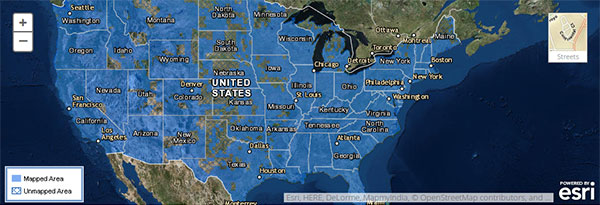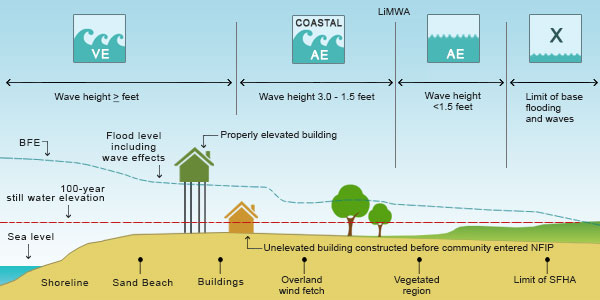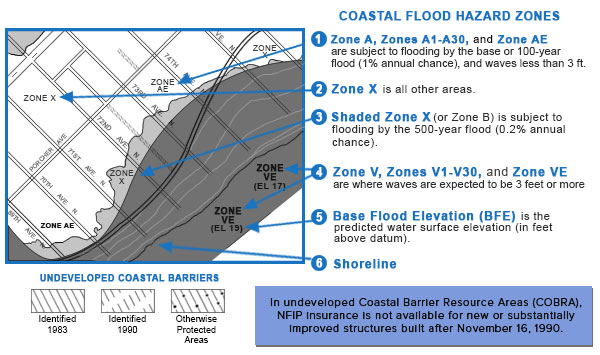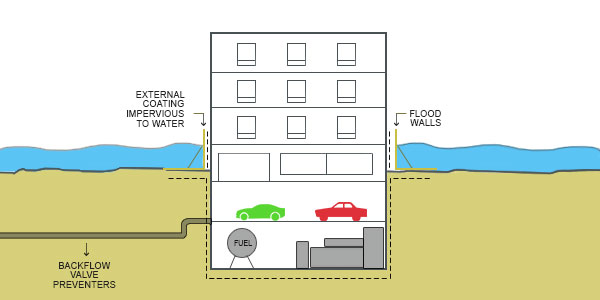 Just imagine walking into your office one morning to discover yourself standing up to your knees in water.
Flooding is the most common and costly natural disaster in the United States. Every year, the United States suffers several billions of dollars in flood damage.
Unfortunately, your business too is not immune to the natural calamities. And the damages can be devastating.
Floods can occur anywhere, often with little or no warning, and leaves everything devastated that comes in its way.
Challenges for business persons dealing with floods are vast. It’s not only about the staffs responding immediately during the outbreak of a flood, but it’s also the duty of a business to ensure that the facility and product inventory are secure so that it could be resumed once the storm is over.
Regrettably, we often learn the lessons of a disaster in hindsight. Things should never take shape that way.
Knowing what to do before, during and after a flood is vital for any business in order to reduce the likelihood of flood damage.
Here is a checklist to protect your business and staff should a flood occur.
Let’s begin.
Just imagine walking into your office one morning to discover yourself standing up to your knees in water.
Flooding is the most common and costly natural disaster in the United States. Every year, the United States suffers several billions of dollars in flood damage.
Unfortunately, your business too is not immune to the natural calamities. And the damages can be devastating.
Floods can occur anywhere, often with little or no warning, and leaves everything devastated that comes in its way.
Challenges for business persons dealing with floods are vast. It’s not only about the staffs responding immediately during the outbreak of a flood, but it’s also the duty of a business to ensure that the facility and product inventory are secure so that it could be resumed once the storm is over.
Regrettably, we often learn the lessons of a disaster in hindsight. Things should never take shape that way.
Knowing what to do before, during and after a flood is vital for any business in order to reduce the likelihood of flood damage.
Here is a checklist to protect your business and staff should a flood occur.
Let’s begin.
1. Assess the risk
There are several flood principles that should be taken into consideration in order to determine how much your facility is exposed to flood waters, the vulnerabilities, and the type of protection needs to be deployed: 1) Duration: It’s significant to know if flood waters will recede quickly or stay stagnant for weeks due to the confounding nature of the topography in your area. The longer your facility remains flooded, the greater the chances are that there’ll be more harm. For example, during the Great Flood of 1993, excessive rainfall in the Mississippi River basin caused significant flooding that did $20 billion in damages over a period of several months. 2) Depth: Flood waters that swell up to more than 3 ft create hydrostatic pressure on walls, which in turn causes cracks in the walls and greatly increases the chances of the facility to collapse. Hence, while building the facility it’s significant that a business owner keeps these things in mind and assumes necessary safety measures while building the bases and ground walls of the facility. 3) Velocity: A flood that arrives at a higher velocity puts more pressure on your facility’s ground walls than stagnant flood waters. Hence, a flood that comes at a higher velocity may damage the walls and structures of your facility beyond repair, and sometimes, may collapse the entire facility. 4) Water condition: Often, flood waters are filthy, briny or contaminated with biological or industrial waste including polluted water, sewage, pesticides, toxic chemicals, and oils. Debris that whirls in the water can impact your facility walls and flood protection systems, create breaches in the protection and cause massive damages. For example, in cities like New York and Chicago, where the older sewage systems carry both sewage and flood waters in the same pipes, remain at greater risk for sewage spills. During heavy rainfalls, these pipes fail the manage the huge volume of storm and wastewater, and unfortunately, often the untreated sewage gets discharged into freshwaters when people swim and play. If you’re not sure about the risk your facility is exposed to, check with your city engineer to evaluate the risks of a flood. It’s a professional who would be able to tell you the projected level of floodwaters in your location. Proximity to water is the prime risk factor for flooding. However, just remaining out of the floodplains won’t help you avoid floods altogether. Still, it’s always a best practice to keep your properties far away from water-bodies. Also, study the historical occurrences of floods in your area due to natural and manmade disasters. There are flood maps available with the National Flood Insurance Program that locate 100-year and 500-year flood zones throughout the United States. Here is an image of the interactive flood map of the U.S. that you could find by visiting the official website of FEMA Flood Map Service Center.
Source: fema.gov
The flood zones also determine your eligibility to participate in the National Flood Insurance Program (NFIP), and avail lower flood insurance rates. Apart from the zones, there are other permissions and requirements that you need to adopt in order to meet the NFIP standards. As per definition, the 100-year and 500-year flood zones mean that based on topography and historical data, there is a 1% chance of flooding annually in a particular area. However, this doesn’t mean that flooding will happen only once in a century or 500 years. Plus, there are other important stuff to consider.- Floods can and often do emerge outside the 100-year flood zones. In fact, about 25% of all floods happen in relatively low-risk areas usually described as being “outside the flood zones.”
- The boundaries of the flood maps may be arbitrary or carry imprecision. For example, a facility standing just outside the 100-year flood zone is almost equally likely to be flooded as one just within.
- Impediments and landfills can change the topography, storm water drainage designs, and water flow over natural floodplains. Although permissions are required to fill flood zones and must be done after scientific assessments ensuring no harm, it’s possible that illegal works have taken place near your facility.
- Just like any other natural calamity, floods show no respect towards what you plan or estimate. As Federal Emergency Management Agency (FEMA) Director Craig Fugate observed following a spate of natural disasters, “It just seemed like it was back-to-back and it came in waves. The term ‘100-year event’ really lost its meaning this year.”
2. Identify breaches
Check to find if you have any breaches in the building from where water is dripping inside. Check your water meter after shutting down all water use in your office. If there is any noticeable change after shutting down usage, you have some leaks in the pipelines. Inspect your floorboards and windows for water damage. Also, make sure to check the efficiency of your appliances that use water. If you find standing water outside it’s another sign of a possible breach. Even outside the floodplains, basements are prone to floods as water may flow down to them. They are also vulnerable to an additional hydrostatic pressure exerted upon them when the surrounding ground becomes saturated. According to many industry experts, elevation is the best way to mitigate risks of damages by flood waters. However, there are a number of additional measures that business owners can take to minimize the scopes of damages due to basement flooding:- Thoroughly inspect the basement and the surrounding areas of the facility to ensure that there are no breaches.
- Extend and redirect downspouts so that the roof-waters can be released away from the basement.
- Re-grade sloping landscape and seal any interior wall cracks.
- Design the basement walls in such a way that those can withstand hydrostatic pressure.
- Use flood resistant materials in floor coverings, wall coverings, and wall insulation. Standard flood resistant materials will be able to resist floodwaters for about 72 hours without being significantly damaged.
- Avoid keeping valuable business equipments and documents in any crawlspace or basement when chances of flooding are high.
3. Elevate and waterproof your office
When it comes to flooding, apart from building your facility outside the 500-year floodplain zone, the best solution would be choosing an adequate elevation. If your facility is already within the 500-year floodplain zone, a solution could be increasing the safety margin by increasing the height of your building above the 500-year flood elevation levels. Flood proofing your building is another way to mitigate the risk of damages due to floods. However, NFIP enforces a number of regulations to develop floodplains at the community levels. You need to have appropriate permission from the authorities to construct new buildings, develop existing buildings, and for any substantial developments to the interior of existing structures within the most hazardous flood zones. A part of the permission procedure involves whether your building site is higher than the base flood elevation (BFE), which is the elevation at which your property has a 1 percent chance of flooding annually, as indicated on the NFIP flood maps. Major storms and flash floods (especially in the coastal areas) often causes floodwaters to rise above the BFE. Here is an image for you to understand.
Source: Floodelevationsurveyors.com
Hence, it’s safe to build a nest several feet above the BFE. This safety zone is called ‘freeboarding’. Below is an easy to understand example of the different coastal flood zones on a typical FEMA flood map.
Source: Floodelevationsurveyors.com
There are also other ways to retrofit your existing structure so that it meets or exceeds the BFEs. However, it’s always advised that you consolidate only what a structural engineer or design professional recommends. The options include raising the foundation onto pilings or columns or adding landfill. However, in order to consolidate, you need to meet the “no impact” floodplain requirements. While elevating a structure, keep the surface of the lowest floor at minimum elevation. Use areas under the BFE only for parking and limited storage. Avoid keeping important and expensive equipments, utilities and ductwork in there. Also, properly anchor the fuel and propane tanks as these become buoyant even in shallow water. Besides elevating your facility, waterproofing it is equally important to mitigate against damages from floods. Your basement is the most important part of your building where waterproofing is needed the most. Below is an easy to understand example as in how floodwaters damage your basement, and eventually, your facility.
Source: Damp-proofing-specialists.co.uk
Basements usually lie below the water table, and usually, they have a protective coating on the exterior walls that prevents water from dripping. However, with time, this protective layer deteriorates and the water seeps through the walls and flooring, thus making them susceptible to dampness and flooding. Well, by waterproofing your basement, you could:- Retain heat during the water season
- Lower energy bills
- Create extra storage space
- Add value to your property
4. Hire a pro
Suspecting a problem won’t fix it. If you think that you are vulnerable to water damage hire a professional water damage consultant who will determine the exact problem. The consultant will tell you if there is a quick fix or a serious retrofit is required. Aggressive approaches include replacing old pipes entirely or raising the structure of your building, which depends on your situation.5. Invest in tech
Begin by installing modern water damage warning systems that will alert to pipe leaks with an alarm and even shut off a faulty valve. ‘Dry floodproofing’ or ‘flood-proofing’ is simply sealing a building so that flood waters don’t enter. In ‘flood-proofing’ a membrane is used to coat your facility’s exteriors to prevent flood waters from entering. As per NFIP regulations, you can make use of flood-proofing as an alternative to elevation above the BFE for newly constructed or substantially improved nonresidential structures. However, though irrelevant, new and improved homes must be elevated above the BFE to meet the NFIP requirements. Another state-of-the-art technology that could provide you additional flood protection is ‘dry flood-proofing’. However, it’s a complex procedure and should be done by professionals. If done incorrectly, it may fail to provide the much needed protection to your facility and decay soon. Here is a figure that could help you understand how ‘dry flood-proofing’ works.
Source: Facilityexecutive.com
Dry flood-proofing is best if your facility is situated in areas with clay soils, and where floodwaters stay for short durations and are usually less than 3 ft deep. Buildings in poor structural condition should never be dry-proofed as the exterior walls will be under extreme pressure during floods. Though there are many measures to make your facility flood-proof, it’s the job of a professional to determine which one suits your building the most. These includes:- Applying a waterproof coating or membrane to the external walls;
- Sealing each and every penetration that peep through the walls, including where utility ducts enter the facility;
- Installing waterproofing shields in every opening - including windows and doors;
- Anchoring each and every buoyant object to keep out from floating;
- Strengthening walls to withstand the pressures creating from the floodwaters and debris.
- Anchoring fuel and propane tanks so that they don’t get swept away. A propane tank leakage may result in fire, explosion, and pollution risks, and has the potential to adversely affect well-being of the people living in the surrounding areas and the environment.
- Installing sewer backflow valves to prevent floodwater from backing up into your home through drain pipes.
- If you’re dependent on a well, protecting it from getting contaminated. Consult a licensed well drilling contractor to make it safe.
- Building your facility with flood damage resistant materials. Building materials are considered flood resistant if they can withstand direct contact with flood waters for at least 72 hours without being significantly damaged. Commonly available flood damage resistant materials include: a. Flooring Materials * concrete, concrete tile, and pre-cast concrete * latex or bituminous, ceramic, clay, terrazzo, vinyl, and rubber sheets and tiles * pressure-treated (PT) or decay resistant lumber * PT wood and cold-formed steel b. Wall and Ceiling Materials * brick, metal, concrete, concrete block, porcelain, slate, glass block, stone, and ceramic and clay tile * cement board, cold-formed steel, and reinforced concrete * polyester epoxy paint * PT and decay resistant lumber * PT and marine grade plywood * foam and closed-cell insulation * decay resistant wood c. Other * hollow metal doors, cabinets, foam or closed-cell insulation
- Elevating the electrical components.
6. Plan ahead
Have a disaster plan in place. A clear written plan makes it easier to remember, communicate, and implement in the event of a flood. If you’re an owner of a small business, it’s absolutely your responsibility to put an emergency plan in place, ensure that the employees are well aware of the it, and effectively put the plan together. It’s advised to have a disaster preparedness kit handy and backup procedures. Once you have an emergency plan in place, review it with a team and key employees. Prepare your staff with drills from time-to-time as in what they should do if a flood strikes. Also, have an exit plan in place. If floodwaters arise from a tropical storm or other reasons, develop a plan to save important business documents, move items from basement and outdoors. Establish an emergency communication method and share it with your employees. Create a contact card having important names and numbers in your wallet to use during crisis periods. Also, set up an alert notification system, phone tree, etc. You might consider the following actions as part of your flood emergency plan:- Turn off gas and electricity supplies
- Send non-critical staff home
- Move valuable portable equipments to higher levels
- Raise elevators to the second floor and turn off
- Stay tuned to the local media
- Evacuate your staff when required
- Raise damp proof courses
- Cover ventilation bricks to prevent water from flowing inside
- Install water resistant skirting boards
- Install non-return valves to sewer drains and water outlet pipes
- Raise electrical sockets, fuseboxes, controls and wiring to at least 5 feet above floor level
- Make sure internal utility fittings are made of watertight materials
7. Get flood insurance
Review your existing insurance policies to see if there is adequate coverage available for your facility and the contents. Usually, contents coverage isn’t included in the main policy and comes for an additional price. So if you’ve expensive equipments in your facility, make sure you get an additional policy for your contents. Most businesses don’t include flood insurance in their policies, which is nothing but a blunder. If you are at all vulnerable to flood damage consider including it in your yearly expense sheet. If you have a leased a facility for your business, check if the building’s flood insurance policy covers structural elements in your space. Also, review equipment lease and rental agreements to determine if you’d be responsible for damages from flood. It’s important that you know how much your property costs (including stocks and business contents) and make sure that your insurance will completely cover your losses. Here are instances when your should review your insurance policy (if there is any):- When you expand your business
- When you relocate
- When you hold additional stocks or contents
- When you upgrade your business equipments
- When you recruit additional staff
8. Keep a record
Keep detailed record of all the contents in the facility, including serial numbers, prices, and dates of purchase. Keep all those documents in water and air proof containers. Make digital copies of all the records keep on a server in your office. Also, keep a backup of the digital copies on a remote server or on a cloud drive. Also (though this is just another risk management strategy, this is important) make sure you keep up-to-date records of your business in a safe and secure location offsite - mainly the accounts. Such a step will help make insurance claims easily apart from running the business after a disaster. Finally, it’s time to take necessary steps so that you can quickly resume operations after suffering a tropical flood. Though flood insurance covers for the damages, many businesses fail to recover fully due to loss of focus, staff, and market share. The Insurance Institute for Business & Home Safety’s Open for Business® planning tool helps small- and mid-sized businesses resume their operations and serve their clients – consider it a vital part of your flood preparation planning and practice. A disaster will strike when you least expect it. Preparing for a flood may be costly but it’ll enhance the viability of your business.Blog Category